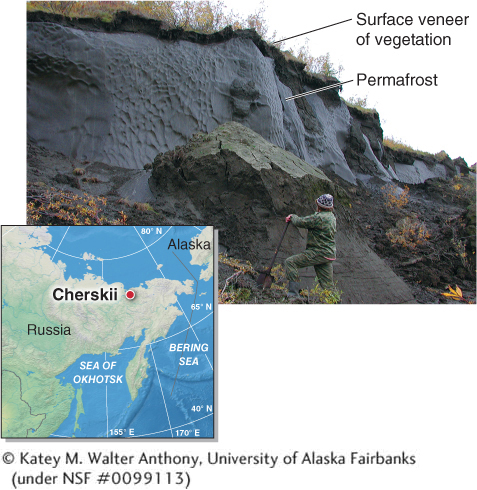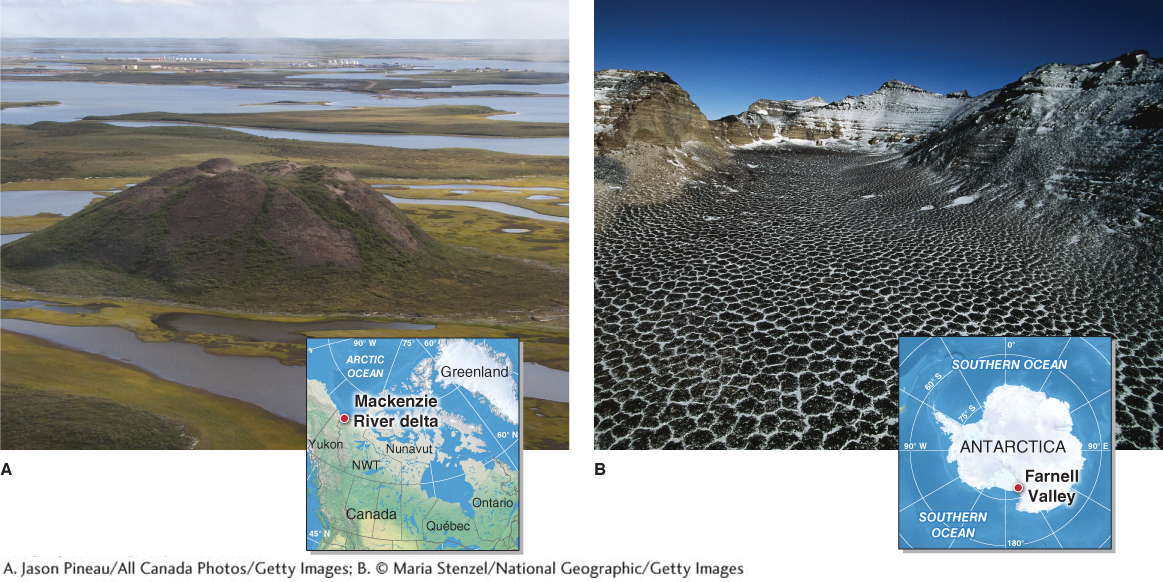17.1 Frozen Ground: Periglacial Environments
Identify features unique to areas with permanently frozen soils and explain environmental changes taking place in those areas.
Periglacial means “around glaciers,” but the term refers to all unglaciated areas at high latitudes and high elevations subject to persistent and intense freezing. As a result of climate change, periglacial environments are one of the most rapidly changing physical systems on Earth. As they change, they are also capable of creating significant climate feedbacks that could further change the global climate system.
periglacial
Of or referring to unglaciated areas at high latitudes and high elevations subject to persistent and intense freezing.
Permafrost
In many regions of Alaska, northern Canada, and Siberia, the ground just beneath the surface veneer of plants and seasonally thawed gelisol soils (see Section 9.1) is perpetually frozen, forming permafrost. Permafrost is ground that remains below freezing continuously for two years or more (Figure 17.2). Not all permafrost is composed of ice. If there is no water in the soil, there will be no ice, only unconsolidated rock fragments at a temperature below freezing. Loose frozen sand, for example, is also permafrost.
permafrost
Ground that remains below freezing continuously for two years or more.

Although permafrost, by definition, remains frozen year-
active layer
The top layer of permafrost that thaws each summer and refreezes in fall.

About 25% of the soils in the Northern Hemisphere have permafrost. At high latitudes, permafrost is typically unbroken, or continuous. Farther south, permafrost may become isolated, sporadic, or discontinuous (Figure 17.3B).
Picture This

Methane from Permafrost
This photo shows researcher Katey Walter Anthony lighting methane gas emerging from a frozen lake on the University of Alaska Fairbanks campus. As the permafrost beneath the lake thaws, anaerobic microorganisms (called methanogens) digest the organic carbon in the soils, producing methane gas as a by-
Question 17.2
Why are explosive gases seeping from Arctic lakes?
As the permafrost beneath Arctic lakes thaws, microorganisms are digesting carbon in the soils and emitting methane, a flammable and potent greenhouse gas.
Two observations are becoming an increasing cause of concern for climate scientists. First, there are some 1.7 trillion metric tons of carbon stored in northern permafrost, twice as much as is currently in the atmosphere. Second, the Arctic is warming about twice as fast as the global average. This warming has the potential to thaw the permafrost and release the stored carbon in the form of methane and carbon dioxide.
A study published in 2012 in Nature finds that permafrost soils could release between 68 billion and 508 billion metric tons of carbon into the atmosphere by 2100. Because methane is such a potent greenhouse gas, scientists are concerned that permafrost thawing could create a positive feedback (see Section 3.6) that could accelerate the warming trend already under way.
Consider This
Question 17.3
How are Arctic lakes becoming sources of methane?
Question 17.4
Outline the positive feedback cycle that could result from permafrost methane production.
Most permafrost is found at 60 degrees north latitude and higher, but it can be found at all latitudes at high elevations. Near the equator permafrost is found at elevations higher than 5,000 m (16,400 ft). Mount Kilimanjaro in Kenya, for example, located at 3 degrees south latitude, has permafrost soil. The thickest permafrost, 1,650 m (5,445 ft) thick, is found in northeastern Russia. The permafrost there is over a half million years old.
The Southern Hemisphere has relatively little permafrost due to its lack of land at high latitudes. Only 0.3% of Antarctica’s land is not covered by the Antarctic ice sheet, and all of that exposed land is permafrost. The Patagonian ice fields in South America and the highlands of the Southern Alps in New Zealand have discontinuous permafrost.
As we saw in Section 6.4, the cryosphere is changing rapidly in response to warming of the atmosphere. Rapid changes are occurring in periglacial environments, particularly in the active layer, as ground temperatures increase (Picture This).
Periglacial Features
Several landforms and phenomena are found only in periglacial environments. Two periglacial landforms are pingos and patterned ground. A pingo is a hill with a core of ice (Figure 17.4A). Pingos form as liquid water from below is forced up through a layer of permafrost. As the water pushes through the permafrost, it forms a mound. Pingos grow at a rate of a few centimeters per year. Patterned ground is formed as freeze-

Trees growing on the active layer above permafrost are shallow-

Structures that radiate heat, such as railways and pipelines, thaw the permafrost beneath them. When permafrost thaws, it becomes unstable, and structures built on it sink into the ground. Such structures may therefore be elevated above the ground to avoid these problems.
The 1,300 km (800 mi) Trans-
